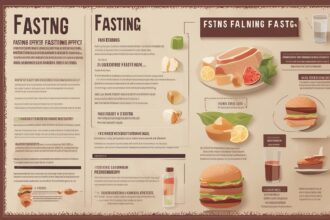Hey there, fellow health enthusiasts! If you’ve been exploring the world of fasting, whether for weight loss, mental clarity, or overall wellness, you’ve likely stumbled upon the term “fasting side effects.” As a key part of any fasting guide, understanding these potential challenges is crucial to ensuring a safe and effective experience. fasting—whether it’s intermittent fasting, water fasting, or another method—can offer incredible benefits, but it’s not without its hiccups. In this comprehensive post, we’ll dive deep into the side effects you might encounter, backed by science, and share actionable tips to navigate them. Let’s unpack what your body might go through and how to make fasting work for you.
What Are the Common Side Effects of Fasting?
When you embark on a fasting journey, your body undergoes significant changes as it adjusts to a lack of regular food intake. While many people experience positive outcomes like improved insulin sensitivity or weight loss, there are some common side effects to be aware of. These are often temporary and tied to your body switching from burning glucose to fat for energy—a process called ketosis (Mattson et al., 2017). However, they can still catch you off guard if you’re not prepared. Let’s break down the most frequently reported issues as part of this fasting guide.
- Hunger and Cravings: It’s no surprise that hunger pangs are a top complaint, especially in the first few days of fasting. Your stomach might growl as it adjusts to new eating windows.
- Fatigue: Feeling tired or sluggish is common as your body adapts to lower energy intake and shifts fuel sources.
- Headaches: Dehydration or low blood sugar can trigger headaches, particularly during the initial stages of fasting (Torelli et al., 2010).
- Irritability: Often dubbed “hanger,” mood swings can occur due to hormonal fluctuations or simply the discomfort of not eating.
Physical Side Effects: What Your Body Might Experience
Beyond the initial discomforts, fasting can lead to more noticeable physical side effects, especially during longer fasts or if you’re new to the practice. As a core component of any fasting guide for beginners, it’s important to recognize that these effects vary based on your health status, hydration levels, and fasting duration. Research shows that while the body is remarkably adaptable, it can react in unexpected ways when deprived of food (Longo & Mattson, 2014). Here are some physical challenges you might face and why they happen.
For instance, dizziness or lightheadedness often stems from a drop in blood pressure or electrolyte imbalances, particularly if you’re not drinking enough water or replenishing salts. Digestive issues like constipation can also pop up since fasting slows down gut motility. In some cases, people report bad breath—yep, “keto breath”—as a byproduct of ketosis, where the body produces acetone (Patterson et al., 2015). While these aren’t usually dangerous, they can be uncomfortable and may discourage you from sticking to your fasting plan.
Mental and Emotional Challenges During Fasting
Fasting isn’t just a physical endeavor; it takes a toll on your mind and emotions too. As someone who’s tried various fasting methods, I can tell you that the mental game is often the hardest part. This fasting guide wouldn’t be complete without addressing how fasting can mess with your mood and focus, especially in the early days. Studies suggest that caloric restriction can influence brain chemistry, impacting serotonin levels and stress responses (Harvie & Howell, 2017).
You might feel foggy-headed or struggle to concentrate, a phenomenon often called “brain fog.” Stress and anxiety can also spike, especially if fasting disrupts your routine or if you’re worried about “doing it right.” On the flip side, some folks report a sense of mental clarity after pushing through the initial hump—something I’ve experienced myself after a few days of intermittent fasting. The key is patience and preparation to handle these ups and downs.
Who Should Be Cautious with Fasting? Potential Risks
While fasting can be a powerful tool for health, it’s not a one-size-fits-all solution. This section of our fasting guide focuses on who might need to approach fasting with extra caution—or avoid it altogether. Certain populations are at higher risk for adverse side effects, and research underscores the importance of personalized approaches to dietary practices (Johnstone, 2015).
- Pregnant or Breastfeeding Women: Fasting can affect nutrient availability, which is critical during pregnancy or lactation.
- Individuals with Eating Disorders: Fasting may trigger unhealthy behaviors or exacerbate conditions like anorexia or bulimia.
- People with Chronic Conditions: Those with diabetes, low blood pressure, or other medical issues should consult a doctor before starting a fasting routine.
- Children and Teens: Growing bodies need consistent nutrition, so fasting is generally not recommended for younger individuals.
- Older Adults: Aging bodies may struggle with nutrient deficiencies or energy demands during fasting.
If you fall into any of these categories, speak with a healthcare provider to weigh the risks and benefits. Safety always comes first when crafting your fasting strategy.
How to Minimize Fasting Side Effects: Practical Tips
Now that we’ve covered the potential hiccups, let’s talk solutions. A solid fasting guide isn’t just about pointing out problems—it’s about helping you overcome them. I’ve gathered some tried-and-true strategies to ease the side effects of fasting, blending personal experience with evidence-based advice. The goal is to make your fasting journey as smooth as possible while still reaping the benefits (de Cabo & Mattson, 2019).
First, start slow. If you’re new to fasting, don’t jump into a 72-hour water fast right away. Try a 12:12 intermittent fasting schedule (12 hours fasting, 12 hours eating) and gradually increase the fasting window. Hydration is also non-negotiable—drink plenty of water and consider adding a pinch of salt or electrolyte supplements to combat dizziness. Eating nutrient-dense foods during your eating windows can prevent deficiencies and reduce cravings. Lastly, listen to your body. If something feels off, don’t push through—break your fast and reassess.
When to Break Your Fast: Listening to Your Body
One of the most underrated pieces of advice in any fasting guide is knowing when to stop. Fasting is meant to support your health, not harm it. While mild discomfort is normal, severe side effects are a red flag. If you experience intense dizziness, nausea, or heart palpitations, it’s time to eat something and seek medical advice if symptoms persist. Research highlights that prolonged fasting without proper monitoring can lead to serious complications like hypoglycemia or dehydration (Wilhelmi de Toledo et al., 2019).
I’ve had moments where I felt “off” during a fast and decided to break it early—and that’s okay. There’s no shame in prioritizing your well-being over sticking to a strict schedule. Keep a small, healthy snack like nuts or fruit nearby for emergencies, and don’t view stopping as a failure. It’s all part of learning what works for your body as you build a sustainable fasting lifestyle.
As we wrap up this deep dive into fasting side effects, I hope this fasting guide has shed light on what to expect and how to handle the bumps along the way. Fasting can be a transformative practice, but it’s not without challenges—hunger, fatigue, and mood swings are just part of the package for many of us. By starting slow, staying hydrated, and listening to your body, you can minimize these effects and make fasting a positive part of your health routine. Remember, it’s a personal journey, so tweak your approach as needed and consult a professional if you’re unsure. Got any fasting stories or tips of your own? Drop them in the comments—I’d love to hear how you’ve navigated this path!
References
- de Cabo, R., & Mattson, M. P. (2019). Effects of intermittent fasting on health, aging, and disease. New England Journal of Medicine, 381(26), 2541–2551. https://doi.org/10.1056/NEJMra1905136
- Harvie, M., & Howell, A. (2017). Potential benefits and harms of intermittent energy restriction and intermittent fasting amongst obese, overweight and normal weight subjects—A narrative review of human and animal evidence. Behavioral Sciences, 7(1), 4. https://doi.org/10.3390/bs7010004
- Johnstone, A. (2015). Fasting for weight loss: An effective strategy or latest dieting trend? International Journal of Obesity, 39(5), 727–733. https://doi.org/10.1038/ijo.2014.214
- Longo, V. D., & Mattson, M. P. (2014). Fasting: Molecular mechanisms and clinical applications. Cell Metabolism, 19(2), 181–192. https://doi.org/10.1016/j.cmet.2013.12.008
- Ageing Research Reviews, 39, 46–58. https://doi.org/10.1016/j.arr.2016.10.005
- Patterson, R. E., Laughlin, G. A., LaCroix, A. Z., et al. (2015). Intermittent fasting and human metabolic health. Journal of the Academy of Nutrition and Dietetics, 115(8), 1203–1212. https://doi.org/10.1016/j.jand.2015.02.018






